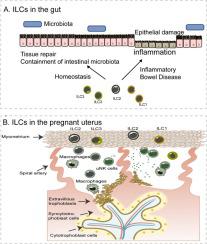Cytokine & Growth Factor Reviews ( IF 13.0 ) Pub Date : 2019-11-15 , DOI: 10.1016/j.cytogfr.2019.11.003 Lin-Chen Tang 1 , Xiang-Hong Xu 1 , Li-Ping Jin 1

|
With the discovery of innate lymphoid cells (ILCs), which are especially enriched in barrier surfaces, the family of innate lymphocytes has grown. A unique characterization of these cells can provide a phenotypical definition of ILCs and their specific functions in different tissue environments. Although ILCs are part of the innate immune system, they are derived from lymphoid lineages lacking rearranged antigen-specific and pattern-recognition receptors. The International Union of Immunological Societies (IUIS) favors the notion that ILCs can be generally divided into five main groups, namely, NK cells, ILC1s, ILC2s, ILC3s and LTi cells. These cells can be specifically stimulated by environmental and pathogen-derived signals. Upon stimulation, ILCs can rapidly secrete a wide range of soluble cytokines that can modulate the functions of effector cells. Over the last decade, ILCs, especially helper ILCs, which do not include NK cells, have been recognized to be a crucial cell type involved in integrating diverse host immune responses. Recently, emerging research has shown that helper ILCs also play a critical role in promoting tissue restoration and immune responses at barrier surfaces. Notably, helper ILCs act as a double-edged sword, being involved in the inflammatory and reparative responses during homeostasis and disease. Therefore, in this review, we summarize the current findings regarding the molecular characteristics and tissue-specific effector functions of helper ILCs in the uterus during physiological and pathological pregnancy and in the intestine during homeostasis and inflammation.
中文翻译:

子宫和肠道中先天淋巴样细胞的分子特征和可能的功能。
随着先天性淋巴细胞(ILCs)的发现(尤其是在屏障表面的富集),先天性淋巴细胞家族得到了发展。这些细胞的独特特征可以提供ILC的表型定义及其在不同组织环境中的特定功能。尽管ILC是先天免疫系统的一部分,但它们来自缺乏重排的抗原特异性受体和模式识别受体的淋巴谱系。国际免疫学会联合会(IUIS)支持将ILC大致分为五个主要组的概念,即NK细胞,ILC1,ILC2,ILC3和LTi细胞。这些细胞可以被环境和病原体来源的信号特异性刺激。一经刺激,ILC可以迅速分泌多种可调节效应细胞功能的可溶性细胞因子。在过去的十年中,不包括NK细胞的ILC(尤其是辅助ILC)已被认为是参与整合多种宿主免疫反应的关键细胞类型。最近,新兴的研究表明,辅助ILC在促进屏障表面的组织恢复和免疫反应中也起着关键作用。值得注意的是,辅助ILC就像一把双刃剑,参与了稳态和疾病过程中的炎症和修复反应。因此,在这篇评论中,



























 京公网安备 11010802027423号
京公网安备 11010802027423号